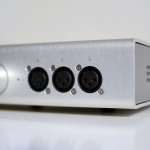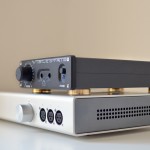This is a high fidelity headphone that will appeal to many listeners, especially those who appreciate full bass and bright treble. From German headphone maker Ultrasone, the open-back Pro 2900 is the top of their professional line. It has been around for a while, and there is a reason for that. It is a comfortable, sturdy, well built and good sounding headphone.
Comparisons
I’ve tried several amps on the Pro 2900 – and the Violectric V200 is the best one so far. It has the ability to tame the upper registries of the 2900, which I sometimes find to be a bit too aggressive. Many amps get a bit bright. Another great match with the PRO 2900 is the Burson Conductor/Soloist, I also found the Lake People G103 good.
This is a review of the Ultrasone Pro 2900, so we will compare it to other headphones using an amplifier that suits it, thus I’ll stick to the V200 throughout this review. The V200 makes every headphone I have tried on it sound very good, so there is no real disadvantage to the other cans. In the following I’ll compare the cans track by track, indicating preferences with an advanced system of preference indcators: A betters B is “A > B”, and “A >> B” iindicates that A is preferred by a very clear margin. ” A = B” indicates that, A is indistinguishable from B, whilst “A >< B” indicates that A and B are different but equally good.
The headphones used for comparison is the Sennheiser HD650, AKG Q701, Shure SRH1840 and of course the Ultrasone Pro 2900, as mentioned, all on the Violectric V200 hedaphone amplifier
Thomas Dybdahl – “This love is here to stay”
Male vocals, bass, percussion, guitar
HD650 is more muffled then the PRO2900, but also has a more intimate way of presentation. More of a laid back and warm sound, while the 2900 takes the lead on clarity and airiness – but also on bass quantity. Different elements of the music stand out more on the 2900, especially the bass. Actually, the bass can stand out too much sometimes, but still I must say 2900 wins on detail, clarity and soundstage. Though, the smooth HD650 has its own charm. The 2900, which I sometimes feel is a bit retracted in the mids, surprised me and made the vocals even more justice than the HD650 on this track.
2900 > HD650
Q701 has a more balanced sound on this track. It is almost as open and clear sounding as the 2900. Problem with the 2900 is that the bass just takes over. It feels over the top in quantity, a shame really – everything else is very good.
Q701 > 2900
SRH1840: The bass in the 2900 is still a bit too full, unless you keep volume very, very low. I feel the 1840 offer the same midrange clarity, while presenting a more balanced tune. 1840 > 2900
Chick Corea – “Pledge for Peace”
Jazzy piano and percussion
HD650: Swapping from the HD650 –every thing gets futher away with the PRO2900, but at the same time clearer and more separated. There’s more sparkle, instruments are placed further apart. Very different but equally enjoyable
HD650 >< 2900
Both the Q701 and 2900 are good on playing the piano. They share many traits, but again the bass is much more dominating on the 2900. Which on this track is a good thing.
2900 > Q701
Shure 1840 is somewhat in between of the HD650 and 701 in sound signature. It presents a much more coherent image of the recording than 2900.
1840 >> 2900
Radiohead – “Morning Bell”
Electronic drums, bass and Thom Yorke singing
HD650: Coming from the HD650 again, I cannot help noticing how very different cans they are. The 2900 feels wide open in comparison to the HD650. But then – it looses out on intimacy. The HD650 has a way of blending all together in a seducing way. Also – the distorted sampled bass on this track just gets too much on the Ultrasones.
HD650 > 2900
Q701 totally lacks the ability to convey the bass line of this track. However, the vocals are more balanced and nice than with the Ultrasone, but the total picture is still in favor of the 2900, although it might be a little too hot in the treble.
2900 > Q701
Shure 1840 gives me the better of both worlds. It is crisp and clear, yet avoiding the slightly fatiguing presentation of the Ultrasone on this brightly mixed track from Radiohead.
1840 > 2900
Jøkleba – “Muggen fallskjerm”
Deep bass drum and sparkly percussion
HD650: The bass sounds lacking and insufficient on the HD650 – as with most cans on this track. The 2900’s combination of a full bass and sparkle in the percussion makes this picky track worth listening to. The usual charm cannot help HD650 on this one.
2900 >> HD650
If the Q701 had more bass, it might have been a contest, since it handles the midrange nd up equally good, but different to the Ultrasone.
2900 >> Q701
Having better all round capabilities than 701/HD650 – the 1840 still cannot reach out to compete with the bass of the Ultrasone.
2900 > 1840
Emerson String Quartet – “Martinu-Poco Allegro”
HD650: On this track the 2900’s treble bites too hard for me, and the increased separation doesn’t compensate for it. The HD650 just is nicer to listen to – and has enough of the stuff that usually gives the 2900 the edge. It just feels more natural and pleasant.
HD650>2900
String music is the stronghold of the Q701, and it even if the 2900 feels more detailed, it doesn’t combine the crispness and fullness in the same way as the 701. Close race though.
Q701 > 2900
The Shure sure presents strings in a nice way. Slightly less open, but as with the above definitely less fatiguing than the Ultrasone.
1840 > 2900
Olga Konkova – “As before”
Piano, Cajon, female vocals
HD650: The deeper bass and greater separation on the 2900 makes a big difference here. But the most difference is on the piano – Ultrasone 2900 is great on reproducing piano. It makes the metallic strings shine.
2900 > HD650
The bass is great on the 2900, and its openness and crispness makes this track fabulous. The Q701 is a little tamer all over.
2900 > Q701
Neither the Shure SRH1840 can match the PRO2900 on this track. 2900 > 1840
Mahler Symphony No.2, Track 3 (Paavo Jarvi)
HD650: The kettledrums sound much fuller on the 2900 – it just digs deeper. The separation of instruments (as always) is better. But the HD650 is getting some points here for its natural and smooth reproduction.
2900><HD650
The Q701 is brighter than the HD650, but still more relaxed and comforting sounding than the 2900, though more lacking in the bass. But the separation and full bass of the 2900 again win some points.
2900><Q701
The Shure does in a way combine the strong points of the 701 and the HD650, and it just feels more right. Despite the delicious deep bass on the kettledrums
1840 > 2900
Conclusion
So, summing it all up, the Ultrasone Pro 2900 fairs pretty well against some of its similarly priced rivals. It offers really great transparency, separation and the soundstage is wide and deep, sometimes at the cost of intimacy. The main issue I have with the 2900 is that the highs and low are quite often a bit too much, making the presentation sometimes sound a bit unnatural with a slight metallic glare. This has its strengths, as when reproducing piano and steel string guitars – that’s a thing the PRO2900 really does well. There is a great sense of instrument separation air, which is a sign of very low general distortion. I must add, however that this comparison was done with an amp that in my opinion favors the 2900, tuning it towards the darker side. I’ve tried it with several amps, and the V200 was the best match I could find. Generally, a darkish amp with a tad more presence in the mids would be a good choice.
In direct comparisons as I have done above, the PRO2900 often gets out ahead. However, during long term listening, the preference shifts. There are two reasons for this. First, a smoother sound can be more tonally pleasant. Second, the 2900 is a bit fatiguing for me in the long run. It is not alone on having me easily fatigued, all Grado’s I have heard, and some high-end phones like TH900, HD800 and T1 also fatigues me easily.
Comparing it to my beloved Audeze LCD-2 rev.1 I find the LCD2 to be on a different level, and I didn’t really prioritize writing up a full comparison. But, given the price it should be that way. They Audeze is not sharing the bass bloom, but digs just as deep, if not deeper. It is never too bright, and never too bassy. A comparison with the closer priced HE500 might be more interesting, but I tend to favor the HE-500 usually by a clear margin. The two mentioned orthodynamics just sound more natural, while still having the bass foundation needed. The general exception in the general preference might be on how the Ultrasone plays the piano, as I have mentioned before. But it is worth repeating: Pro 2900 is really great doing the piano.
Basically, it is an exceptionally good “bright-and-bassy” headphone that might be perfect for some, but that also might not be for those who, like myself, fatigue easily. For some tracks, however, it is absolutely stunning, and might be worth keeping just for those musical pieces where its special sound signature brings out all the good stuff. Just make sure you don’t pair it with an amplifier that tips it too far over to the bright side.
Specifications
Sound pressure level 96 dB
Impedance 40 Ohm
Dynamic driver, open constructionFrequency range 6-42.000 Hz
Driver 40 mm titanium-plated
Weight 295 g (without cord)
More info here




